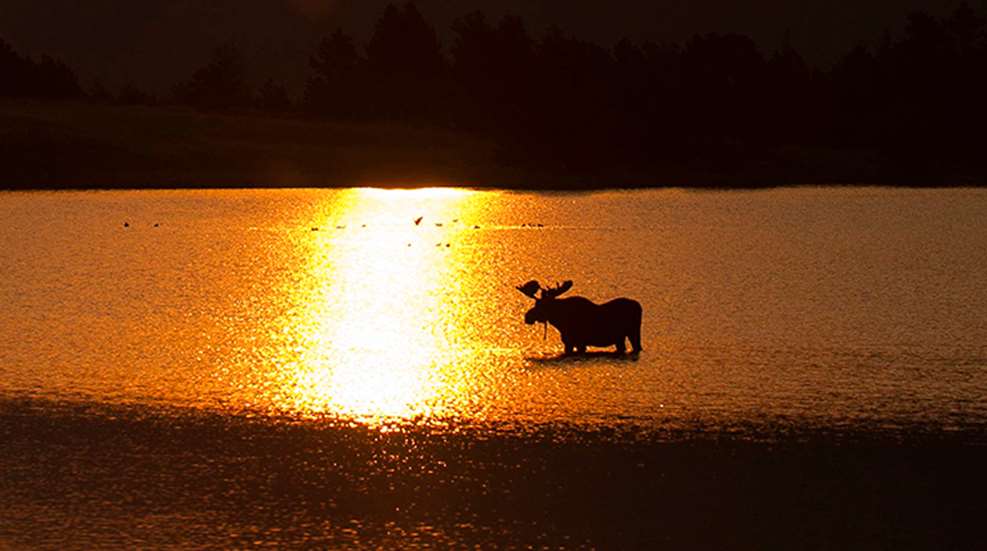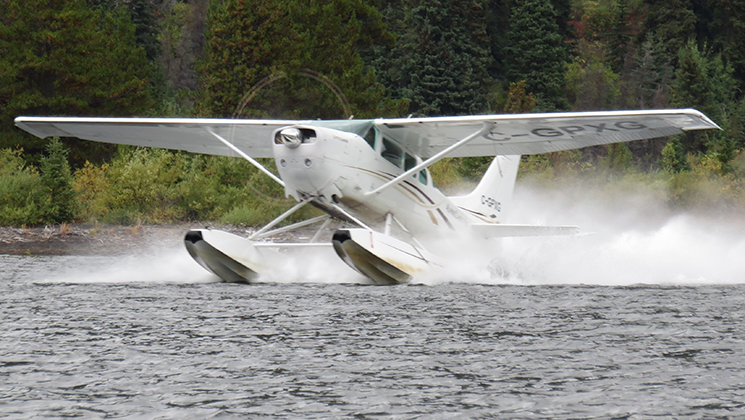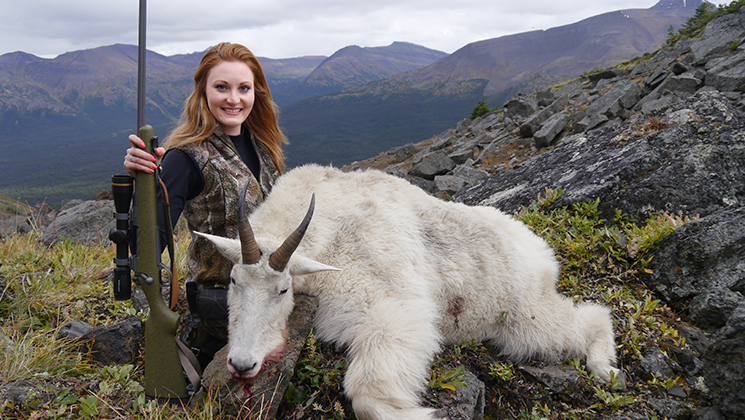
We took an inflatable boat up to the head of the lake to get a better vantage point. The wind was whipping that afternoon but, ever the optimist, as we set up to glass I told Ron Fleming there should be a bear up on a grassy slide across the lake. The binocular cups hardly touched my face when, on command, a bear walked into my field of view. Unfortunately it was the wrong kind of bear: We were looking for a grizzly, and this was a big black bear. I didn’t have a tag, and even if I did it wouldn’t have mattered; it was getting late in the hunt, and we needed to keep our eyes on the main goal. Still, it was good to see that bear scarfing berries while the wind rippled its coat. Even better, I’d scooped Fleming on spotting it, and I wasn’t about to let him forget it.
This time I’m not building suspense. We never saw the big grizzly we were looking for, nor a close approximation. Early September is usually glorious in northern British Columbia, but in 2016 it was awful, rain and fog. If you can’t see you can’t glass. I think we had “huntable” conditions maybe three and a half days out of 10. My wife, Donna, got a very nice goat after some brutal climbs … and I never fired a shot. Even so, it was an excellent hunt. Northern B.C. offers some of the most spectacular country on Earth … when it’s clear enough to see it. When it wasn’t we had a snug cabin to hole up in. I caught up on sleeping and reading, and we swapped stories with Ron and his wife, Brenda. Stories they have; they’ve been hunting their guide territory for 40 years.
I’ll admit it: There was a time when lack of success would have bothered me a lot more. For sure it still isn’t my preference, but that’s not what quality of experience is based on. It’s more about the country, the people a camp is shared with and honest effort. We put in the honest effort on Donna’s goat. Also, this wasn’t her first attempt for that animal, so that was always the main goal of the hunt!
The Country
Of the many places I’ve been there are few I wouldn’t like to see again, but I’m compelled to return to the mountains of western Canada every chance I get. Despite my longstanding and incurable addiction to Africa, Canada’s westernmost wilderness is my favorite hunting country. I have by far the most experience in British Columbia, but in my mind I’m pretty much lumping together B.C., Yukon and the MacKenzies of Northwest Territories.
So, the obvious question: Why not Alaska? Alaska is wonderful. I’ve enjoyed many great hunts there and hope I have a few more left in me. However, Canada’s western mountains are generally a bit gentler. Much of this region also lies farther south than Alaska, so game densities are often higher and the variety is greater. In today’s world, most Alaska hunting is fairly specialized. Mind you, I’m speaking primarily of mountain hunting; I’m not trying to compare a coastal brown bear hunt or float trip for moose with alpine pursuits.
I first saw the mountains of northern British Columbia back in 1973. Although quite young, I’d hunted the Rockies of Colorado, Wyoming and Montana. I guess you always want what you don’t have, so as a kid from flat Kansas I was always fascinated by mountains. Northern British Columbia in August struck me as the most beautiful country I’d ever seen: timbered, well-watered valleys, and green alpine basins below rocky caps patched with permanent snow and ice. More than 40 years later I still think of it as the most beautiful country I’ve ever seen. I suppose I’ve returned to B.C. more than a dozen times, but I’ve also hunted Yukon and the MacKenzies, and I’ve added them on the same “favorites” bar.

The Game
In northern B.C., the premier game is probably Stone sheep. I was lucky: When Dad and I hunted there in ’73 the quota system didn’t exist, and I took a nice ram at a laughably low price by current standards. Today prices have skyrocketed, and the dark sheep in southern Yukon also command a major premium. This is regrettable because I think the Stone sheep is the most beautiful wild sheep; I would hunt them more if I could afford it. But I cannot, and this doesn’t really matter. Most of Yukon and the MacKenzies have pure white Dall sheep, today the most available and affordable of our wild sheep, and they offer the same experience. Southeastern B.C. has Rocky Mountain bighorn, while central B.C. has the slightly smaller California bighorn race. Today both also command prices above my pay grade, but the hunting is good.
Rocky Mountain goats share the Stone sheep range, and are also numerous in most B.C. ranges. In B.C., more goats probably die of old age than are taken by hunters. The goat is the hidden gem, an equal experience to any sheep hunt—often harder because goats live in rougher, steeper country than sheep—at a fraction of the cost. North of B.C. goats peter out quickly, but they are also available in a couple of guide territories in southern Yukon and the MacKenzies.
Black bears also thin out in the far north, but they may be found almost anywhere. In Yukon’s Bonnet Plume range in 1999, my buddy Mike Satran, our respective guides and I returned from separate spike camps at about the same time, heavily laden with Dall sheep horns, capes and meat. There was a big black bear picking berries about a half-mile above camp. Mike and I each tried to talk the other into going after him, but we were both too exhausted … and of course we never saw that bear again.
In southern and central B.C. black bears are plentiful, a great and generally inexpensive spring hunt. The hunting there is by spot-and-stalk, an enjoyable way to hunt bears in country where glassing is possible. As a bonus, on the mainland of B.C. black bears range from blond through shades of brown to black, with two bears generally allowed on license.
Grizzly bears need a lot of country, so populations aren’t dense, but overall numbers are high and generally increasing throughout the region. Grizzlies are hunted in both fall and spring seasons in B.C. and Yukon; there is no grizzly season in the MacKenzies. Because it is more southerly, with shorter hibernation periods—and also offers the opportunity to hunt fish-fed coastal bears in some areas—B.C. likely produces bigger grizzlies than Yukon, but both are very good. Honestly, though, the likelihood of taking a grizzly “incidental” to a fall hunt for other game is fairly low. The best way to hunt grizzly bears, always, is to hunt specifically for grizzly bears. I shot my first grizzly in the Kootenays in 1974, another in the Skeena Mountains 15 years later. With a big grizzly from Arctic Alaska I’m sort of done … but I’m still looking for a very special bear (which I might or might not shoot).
Moose are widespread throughout the region, generally getting larger in both body and antler—but probably diminishing in density—as you move north. Although accepted as such by Safari Club International but not by Boone and Crockett, the smaller, darker moose in southeastern B.C. are probably Shiras moose. Without question northern B.C. produces the largest Canada moose, while the moose of both Yukon and the MacKenzies are the extra-large Alaska-Yukon variety. Although moose, especially bulls, may be found quite high, they are primarily creatures of the valleys and forests. The real difficulty of combining moose with mountain game, however, is the best moose hunting is during the late-
September rut. This is toward the end of the season, when the mountains have become icy and treacherous and most sheep and goat hunting is finished. Years ago I combined moose and goat in the Kootenays of southeastern B.C. and was successful on both—but the goat hunting in deep snow was tough and scary.
In northern B.C., southern Yukon and the southern MacKenzies, the caribou are mountain caribou; to the north the caribou are barren ground, the same as Alaska caribou. Mountain caribou in northern B.C. continue to decline; realistically, only a handful of mountain caribou are taken annually in B.C. these days. In Yukon and the MacKenzies, it’s very possible to combine moose and caribou, which assumes the logistics (horses, boats or Argos) to recover the meat. On backpack sheep hunts you may well see spectacular caribou—I have—but there’s not much to be done about it. That said, in Yukon in ’99 we did a backpack hunt for sheep, and then saddled the horses to hunt other game. That was far enough north that these were barren ground caribou, and to date that Yukon bull is my only barren ground caribou.
Southeastern B.C. has long been good for elk, but today there’s good elk hunting well into traditional Stone sheep range. The northern B.C. herd, centered in the Muskwa drainage, is now about 18,000, with another 20,000 in the southeastern Kootenay region; other B.C. herds are smaller and more localized. I haven’t personally hunted elk in B.C., but both hunting and trophy quality are good, and the potential combinations along with “northern” species are interesting.
Southern and central B.C. offers very good mule deer hunting, with big northern whitetails in the valleys and near farmlands. This region, however, is not a whitetail destination like Alberta and Saskatchewan. Rounding out the big-game picture, in both central and southern B.C. houndsmen offer winter hunts for cougar, lynx and bobcat. Wolverines, though widespread, are so thinly distributed as to be almost impossible to hunt on purpose. I’ve actually seen a couple but never when the season was open. Wolves, on the other hand, are generally plentiful. Although many hunters have taken wolves incidental to other hunts I never have. But one should always have a wolf tag just in case. The wolf is catching on as desirable game, and these days more outfitters are offering winter wolf hunts. There are no guarantees, but if you want a wolf that’s a better way to go about it.
The Traditions
Throughout the region nonresidents must be guided, and unfortunately I haven’t seen any hunts get cheaper over the years. Common to the region, however, is a system of exclusive guide territories, held in perpetuity provided the holder of an area maintains sound stewardship. A guide territory can be sold or willed, so in our 21st century very few remain under original ownership. Even so, there’s a huge body of local hunting experience in this region, with long-time outfitters and long-time guides bringing up youngsters who start as packers, become guides, and perhaps someday take the plunge and purchase a guide area that comes up for sale.
There was sport hunting in at least part of the region as early as the 1930s. Back then hunts were serious expeditions requiring days of travel by horseback to reach good country. It wasn’t until after World War II that things really got going, with some guide territories pioneered and carved out as late as the 1960s and beyond. As it developed, outfitters trailed in horses in summer, with hunters gaining ready access by floatplane during the season. Today some areas have road access and riverboats are occasionally used. A few outfitters have gone to Argos, especially for moose hunting, and, depending on the area, much sheep and some goat hunting is done by backpack. In general, however, this region is one of the last bastions of the old-time pack-string hunt. Virtually all of the outfitters and guides from the 1960s are gone or retired. But many of today’s guides and outfitters are their sons, daughters, grandsons and granddaughters.
The Hunt
Since a guide territory is actually owned, an outfitter can feel secure in developing the area, over time increasing its value. Freighting in material, usually in winter, is costly, so fancy lodges aren’t common, but permanent base camps comprised of snug, comfortable cabins are. However, depending on species and conditions you may not see much of that warm cabin! In the Arctic Red River area of the MacKenzies I saw the cabins twice, once on the way in and once on the way out. In between, my guide and I were dropped by Super Cub on a gravel bar and picked up with our ram two weeks later. In Yukon and B.C. I’ve both spiked out and hunted from permanent camps.
Horseback hunts are marvelous, a wonderful way to see the country, a great way to cover ground and a fantastic way to recover game. But not all northern outfitters use horses today, and sometimes the hay burners don’t make sense. Much goat country is simply too rough for horses, and in almost all mountain hunts sooner or later you must tie up the horses, which means you have to return to them. Backpack hunting is thus often a viable option, but it depends on the area and the outfitter. In Yukon in ’04, Dwight van Brunt and I did a Stone sheep hunt with Randy Babala, a great sheep hunter and serious horse outfitter. We rode and glassed vast distances every day, but every night we were back in a warm cabin, where we were fed like kings.
In west-central B.C.’s Chilcotin region I did two goat hunts with Mike Hawkridge, a great young outfitter, deadly serious about his horses. We rode a full day to get into good goat country, making a tent camp with an old cabin as a cook shack. From there we could take the horses up one valley or another, but the goat hunting (as always!) was strictly on foot from near the bottom. I’ve also done two goat hunts with Ron Fleming, one for my daughter Brittany and most recently for Donna. This was quite a different deal. Fleming’s several camps have cabins on a lake shore, access by floatplane, and boats to move up and down the lakes. The goat mountains rose behind camp and across the lake, so we could sit in chairs by the cook shack and glass goats while munching one of Brenda’s famous pastries. When weather and a billy goat’s position allowed we could run up the mountain, which wasn’t easy. A warm cabin was sure nice to come back to.

In northern areas weather is a factor, and has much to do with whether a hunt is successful. Despite great areas and effort, some are and some aren’t, but if you believe a hunt is truly about the experience and not altogether about filling tags, then this is country you need to see, and you need to see it with a good, experienced outfitter who can really show it to you.
I’m nuts about bears and I love sheep and goats—I’ve done a lot more goat hunting than sheep because goats are affordable and sheep are not, and for sure I’ve done a lot more black bear hunting than grizzly hunting. Although I’ve hunted both and probably will again, neither moose nor caribou push my personal hot buttons. Elk are interesting, but I’ve done my elk hunting in the Lower 48. But here’s the real point: Provided only that it’s of interest to you, it doesn’t really matter what game you hunt up there. And it doesn’t matter how you do it. I won’t be backpack hunting for many more years, but there are still horses and boats. Spike camps are still fun, but snug cabins are awfully cozy. The options are there, so are some of the world’s best outfitters and so is the country. You’ll love it, and you need to see it at least once.




































